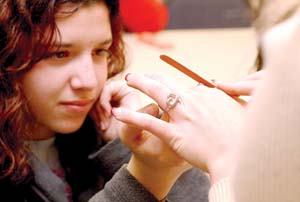A 44-year-old woman is the first local victim of the H1N1
influenza virus, formerly known as swine flu, according to the
Santa Clara County Public Health Department.
A 44-year-old woman is the first local victim of the H1N1 influenza virus, formerly known as swine flu, according to the Santa Clara County Public Health Department.
The woman was a Santa Clara County resident who had underlying health conditions unrelated to the virus. Health officials announced her death Tuesday.
“Our sympathy goes out to this woman’s family and friends,” said Dr. Marty Fenstersheib, Health Officer for Santa Clara County. “Her death is a sad reminder of the seriousness of influenza.”
A spokeswoman for the county health department declined to name the victim or specify in what area of the county she resided. Since the virus has spread throughout the county in recent months, all local communities should be aware of the virus’s presence, according to Joy Alexiou of the county health department.
The H1N1 virus which was first discovered to have infected humans in April has since spread to a pandemic that has led to the deaths of 429 patients in more than 100 countries. At least 170 people have died of H1N1 in the United States as of July 6, according to the World Health Organization.
The county health department reported 172 cases of the pandemic H1N1 virus as of Monday, as well as 109 confirmed cases and 63 probable cases. Thirty-two of these cases have led to hospitalizations.
Since systematic testing for the virus has been replaced by testing hospitalized patients with flu-like-illness, these numbers do not accurately reflect how widespread the virus is circulating throughout the county, according to a statement from the health department.
The median age of local H1N1 patients is 16, with the highest proportion of cases occurring in those between the ages of 5 and 24. Few cases and no deaths have been reported among residents older than 64 years old, which public health officials say is unusual for any flu virus.
Another unusual aspect of the H1N1 virus is it is still present in the summer, Alexiou said. *”People should still be aware that it’s out there,” she said.
She added local residents should take the following common sense precautions:
– If you are feeling sick stay home from work or school. If your symptoms get worse, call your physician or medical provider.
– Wash your hands with soap and hot water to get rid of germs and prevent the spread of disease, especially after coughing and sneezing. If you do not have soap and water, use a waterless hand gel with an alcohol base of at least 60 percent.
– Cover your mouth and nose with a tissue whenever you sneeze and cough. Throw the tissue away in a waste basket. If you do not have a tissue, sneeze or cough into the fold of your elbow, without using your hands.
Health officials say they continue to learn more about the pandemic virus every day. The actions and guidance of the Public Health Department may change in response to what is learned.
In late April, initial swine flu fears led local school officials to close Rucker Elementary School in Gilroy for a couple of days when a handful of students showed flu-like symptoms. However, those students’ H1N1 tests came back negative.
Health officials will provide additional information as it becomes available, but right now you can go to www.sccphd.org or visit www.cdc.gov for more information.










